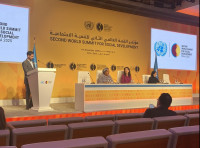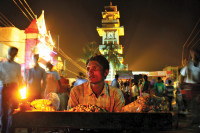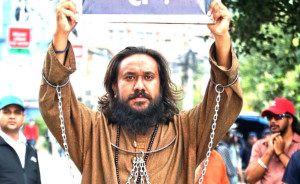Columns
Lessons to be learnt from Saarc’s stagnation
The regional grouping has been largely nonfunctional because it hasn’t been able to adapt to the evolving regional set-up.
Mahendra P Lama
The regional cooperation process in South Asia had been triggered by the failure of North-South Negotiations of the 1960s and 1970s;emergence of South-South Dialogue among the developing countries in the 1980s; the urge to harness huge potentials of ‘regionness’ and smaller countries’ bid to create regional platform to deflect and minimise their perceptions about Indian ‘hegemonic’ practices. Since the South Asian Association for Regional Cooperation was launched in 1985,18 summit meetings have taken place and its declarations are perfect official documents. However, in reality, there has been little to demonstrate. Nothing much has percolated down to societies and communities. Dismal commitments, protracted India-Pakistan imbroglios, the principle of ‘unanimity’ and a dearth of coordination among national and sectoral focal points have stunted its growth. Besides the fear of Indian domination, severe institutional weaknesses, poor alignment of Saarc issues with national priorities, absence of monitoring and evaluation and deficiency in acceptable and visionary regional leadership have added to its laggardness. Activities are just initiated as summit rituals. Unless the regional partners rethink an innovative model and pragmatic modalities, Saarc would remain moribund and decrepit.
Purpose and performance gaps
Saarc has been deliberately designed to be an institution of the government, by the government and for the government. It has now become a victim of governmental lethargy, bureaucratic inhibitions and, more critically, national prejudices. There is very little scope for the private sector, civil society, academics and South Asian communities to play any significant role. Nine other countries with ‘observer’ status including the EU, China, US and Japan have also remained clueless in terms of their role and future. Even South Asia Forum, a regional think tank launched with much fanfare during the Thimphu Summit in 2010, remains dilapidated. It just met once in New Delhi in 2011. This Forum was set up for the ‘generation of debate, discussion and the exchange of ideas on South Asia and its future development.’
There are umpteen examples of how Saarc as an institution and its members have willfully not implemented the decisions taken at the Summit level. This has consistently been followed by a ‘practice’ where the summit leaders make announcements and never implement them, thereby sharply eroding the peoples’ confidence and trust in the regional grouping. Questions have been raised regarding the ability of the member countries to operationalise what they collectively decide. The grouping’s declaration about poverty eradication and the virtual non-implementation of the anti-terrorism convention and the Saarc Food Bank provisions introduced in 1987 are indicative examples.
Poverty eradication
The 6th Saarc summit held in 1991 in Colombo for the first time accorded the highest priority to the alleviation of poverty in South Asia. It established an Independent South Asian Commission on Poverty Alleviation consisting of eminent persons from member states to conduct an in-depth study of the diverse experiences of member states. The Commission in its report provided a radical conceptual framework for poverty alleviation through social mobilisation and empowerment along with setting formidable macro-economic targets for the eradication of poverty by 2002.
The report discussed various micro-level interventions and learning from the tedious delivery systems of the state mechanism. As a corollary, a new understanding emerged and focus has gradually shifted from macro interventions to participatory micro-development organisations. All the micro-level success stories of poverty alleviation in South Asia including Rural Advancement Committee of Bangladesh, Aga Khan Rural Support Programme of Pakistan, Small Farmer Development Programme of Nepal and Janashakti Banku Sangam of Sri Lanka have indicated that where the ‘poor participate as subjects and not objects of the development process, it is possible to generate growth, human development and equity.’ Most of these success stories are built upon participation and community effort relying on societal experiences, memories and mobilisation systems.
To implement the recommendations of this report, the 7th Saarc Summit held in Dhaka in 1993 for the first time committed to eradicating poverty in South Asia by 2002. However, it undertook a meagre number of inconsequential initiatives during the critical 1993-2002 period. For many years, however, all the SAARC Summit declarations reiterated their stand of 1993 to ‘eradicate poverty from the region by 2002’. Come 2002, the Kathmandu Summit of 2002 appointed another Commission on Poverty Alleviation. In fact, even the wordings and expressions related to poverty eradication remained strikingly similar to many previous summits. The implementational issues seldom figured. And in the last 18th Summit held in Kathmandu in 2014 the leaders once again reiterated the same old purpose of alleviating poverty.
Low politics item
How to raise the entire spectrum of regional cooperation from a low politics item to a high politics agenda in South Asia should, in fact, be a crucial agenda in deliberation among political parties, parliaments and governmental actions across the region. Only this will provide Saarc with a regional agenda status that would bring people, the geography and the governments together and provide a new ‘regionness’. This also implies accepting the increasingly visible role of multilateral players like the World Bank, Asian Development Bank, UN agencies, Asian Infrastructure Investment Bank (AIIB) and donor agencies. This is what has given an inclusive and win-win profile to nearby groupings such as the Greater Mekong Subregion, Central Asia Regional Economic Cooperation and Association of South East Asian Nations.
With six of SAARC’s eight members as signatories to the $100 billion AIIB and China’s Belt and Road Initiative literally garlanding South Asia with connectivity projects, the region has a narrow but far-reaching choice. It could either continue to adopt conventional incremental ‘change’ with a top-down approach or use ‘transforming instruments’ like market-expansions and trans-border multi-modal interconnections. India, as a regional pivot, understands well that if it does not participate in the regionalism process to the fullest extent, it will be far behind China’s effective entry, penetrative practices and durable presence in the societies and economies of this region. In such a situation, the question of China’s membership to Saarc will only oscillate between de-jure presence and de-facto entry. In that case, whether China wants to enter into this regional ‘bloc’ from outside or inside would largely remain an academic question only.
Another foreseeable challenge for the region is to increasingly adapt sub-regional pathways for consolidating regionalism. Specific project-based sub-regionalism model like the BBIN (Bangladesh, Bhutan, India and Nepal) initiative is emerging as an acceptable and beneficial sustainable alternative. This is somewhat in the line of successful models like the Greater Mekong Basin Growth Triangle among Southeast Asian nations and China. Here, local geographies participate and focus shifts to borders as opportunities. In this model, natural resources and bio-diversity that acquire core importance and connectivities are revived and rebuilt, and cultural and historical heritages are rediscovered. More seriously political consensus-risks-failures are localised wherein cooperation starts from below, and traditional constraints are frozen and national prejudices are sidetracked.
Regional observers are at pains to describe Saarc as ‘ritualistic’, and criticise it as a ‘magnificent paper tiger’, ‘a political white elephant’, a ‘talk shop of no consequence’, and ‘suffocatingly slow’, among other colourful descriptors. The Secretariat in Kathmandu is a perfect symbol of the ethos and direction of this regional body. As an institution, it has neither grown nor diminished and has neither been lively nor lifeless. It is exactly like the state of India-Pakistan relations of ‘no war yet no peace’. The vital regional centres launched with so much fanfare have now been closed down. However, despite all these limitations, ‘non-governmental Saarc’ and ‘people’s Saarc’ have made significant progress thereby indicating some semblance of ‘new regionalism’ process setting into this region.
- Lama was a nominated to the South Asia Forum by the Government of India in 2011.




 14.12°C Kathmandu
14.12°C Kathmandu















